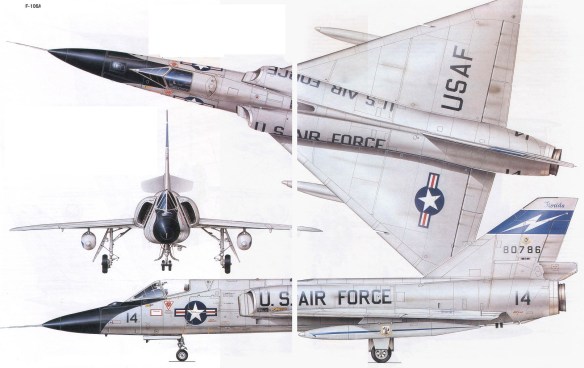
The Delta Dart guarded U.S. skies from Soviet bomber attacks for more than two decades. One of the most automated airplanes in history, its pilots did little more than direct takeoffs and landings.
The F-106 was originally a modification of the earlier F-102, but the changes proved so extensive that a new designation was warranted. Although it used the same wing, the fuselage was completely refined to incorporate a J57 engine with twice the power, and the air ducts were moved further aft for increased efficiency. The prototype first flew in 1957 and set a world absolute speed record of 1,525 miles per hour—two and a half times the speed of sound. Two more years of development were required before the F-106, christened the Delta Dart, was accepted into service. A total of 257 fighters and 63 two-seated trainers was built; they equipped 14 Air Defense Command squadrons by 1961. The F-106 was the most elaborately equipped fighter interceptor in history. Its MA1 fire-control system was tied into the semiautomatic ground environment (SAGE) defense network; SAGE could quickly direct the F-106 to any threatened point within the United States. Once a target was identified, onboard computers would launch either radar-guided Falcon or nuclear-tipped Genie missiles before standing off. Delta Dart pilots had little to do but take off, monitor instruments, and land. This capable aircraft was continually updated over the years with new avionics and armaments, and it remained the frontline of American defense for 25 years. It then flew with Air National Guard squadrons before retiring in 1988; many ended their days as expendable QF-106 target drones.
Type: Fighter
Dimensions: wingspan, 38 feet, 3 inches; length, 70 feet, 8 inches; height, 20 feet, 3 inches
Weights: empty, 24,420 pounds; gross, 34,510 pounds
Power plant: 1 × 24,500–pound thrust Pratt & Whitney J57 turbojet engine
Performance: maximum speed, 1,525 miles per hour; ceiling, 57,000 feet; maximum range, 1,800 miles
Armament: 1 × 20mm Gatling gun; 2 × AIM Falcon missiles; 1 × nuclear-tipped AIR2 Genie missile
Service dates: 1959–1988